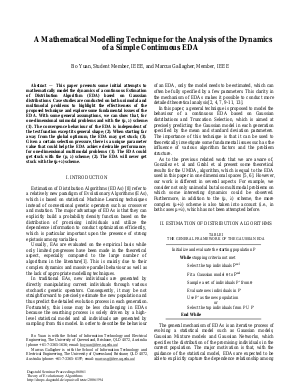A Mathematical Modelling Technique for the Analysis of the Dynamics of a Simple Continuous EDA
Authors Marcus Gallagher, Bo Yuan
-
Part of:
Volume:
Dagstuhl Seminar Proceedings, Volume 6061
Part of: Series: Dagstuhl Seminar Proceedings (DagSemProc) - License:
 Creative Commons Attribution 4.0 International license
Creative Commons Attribution 4.0 International license
- Publication Date: 2006-07-07
File

PDF
DagSemProc.06061.3.pdf
- Filesize: 437 kB
- 7 pages
Document Identifiers
Subject Classification
Keywords
- Estimation of Distribution Algorithms
Metrics
- Access Statistics
-
Total Accesses (updated on a weekly basis)
0PDF Downloads0Metadata Views
Abstract
We describe a mathematical model for the infinite-population dynamics of a simple continuous EDA: UMDAc. Using this model, it is possible to numerically generate the dynamics of the algorithm on a fitness function of known form. The technique is compared with existing analysis and illustrated on a number of simple test problems. The model is also used to examine the effect of adding an amplification constant to the variance parameter of the UMDAc model.
Cite As Get BibTex
Marcus Gallagher and Bo Yuan. A Mathematical Modelling Technique for the Analysis of the Dynamics of a Simple Continuous EDA. In Theory of Evolutionary Algorithms. Dagstuhl Seminar Proceedings, Volume 6061, pp. 1-7, Schloss Dagstuhl – Leibniz-Zentrum für Informatik (2006)
https://doi.org/10.4230/DagSemProc.06061.3
BibTex
@InProceedings{gallagher_et_al:DagSemProc.06061.3,
author = {Gallagher, Marcus and Yuan, Bo},
title = {{A Mathematical Modelling Technique for the Analysis of the Dynamics of a Simple Continuous EDA}},
booktitle = {Theory of Evolutionary Algorithms},
pages = {1--7},
series = {Dagstuhl Seminar Proceedings (DagSemProc)},
ISSN = {1862-4405},
year = {2006},
volume = {6061},
editor = {Dirk V. Arnold and Thomas Jansen and Michael D. Vose and Jonathan E. Rowe},
publisher = {Schloss Dagstuhl -- Leibniz-Zentrum f{\"u}r Informatik},
address = {Dagstuhl, Germany},
URL = {https://drops.dagstuhl.de/entities/document/10.4230/DagSemProc.06061.3},
URN = {urn:nbn:de:0030-drops-5940},
doi = {10.4230/DagSemProc.06061.3},
annote = {Keywords: Estimation of Distribution Algorithms}
}
